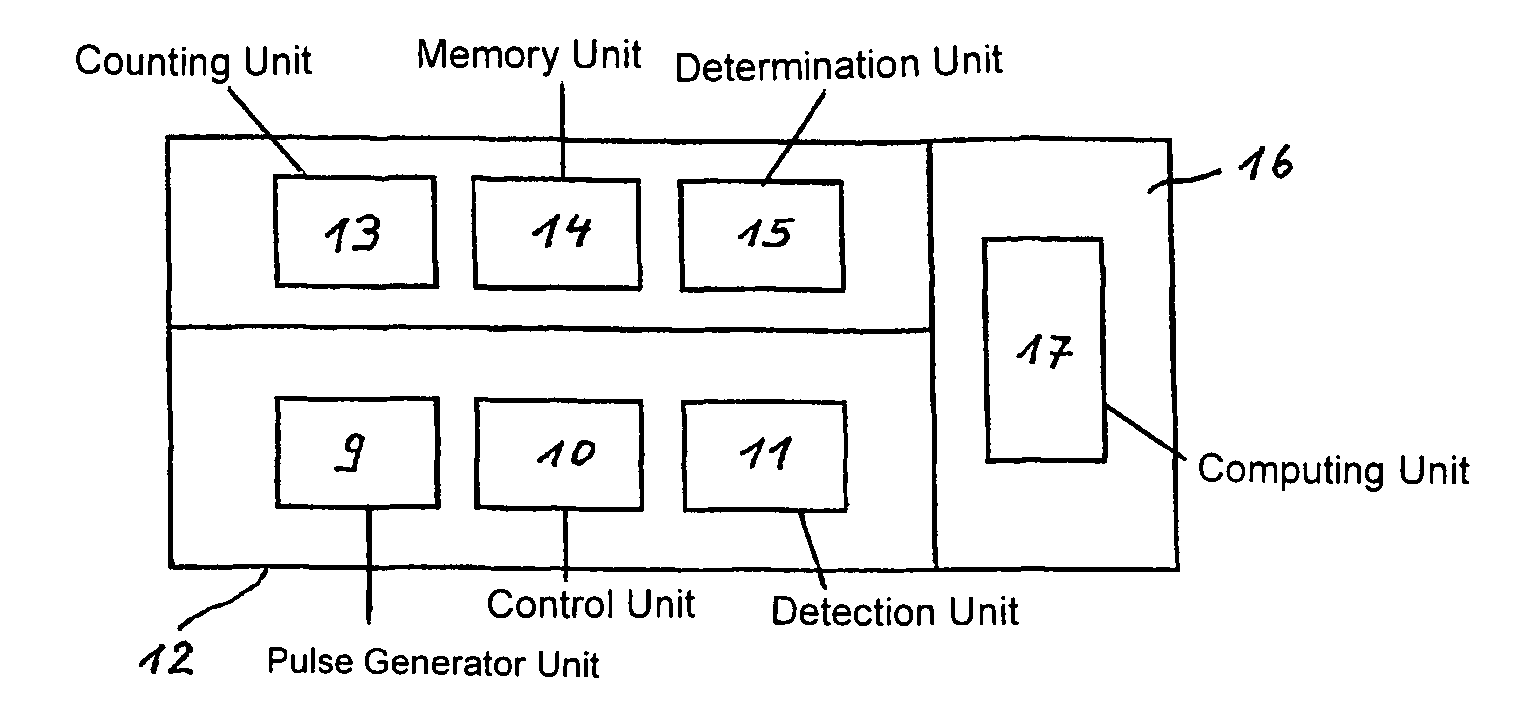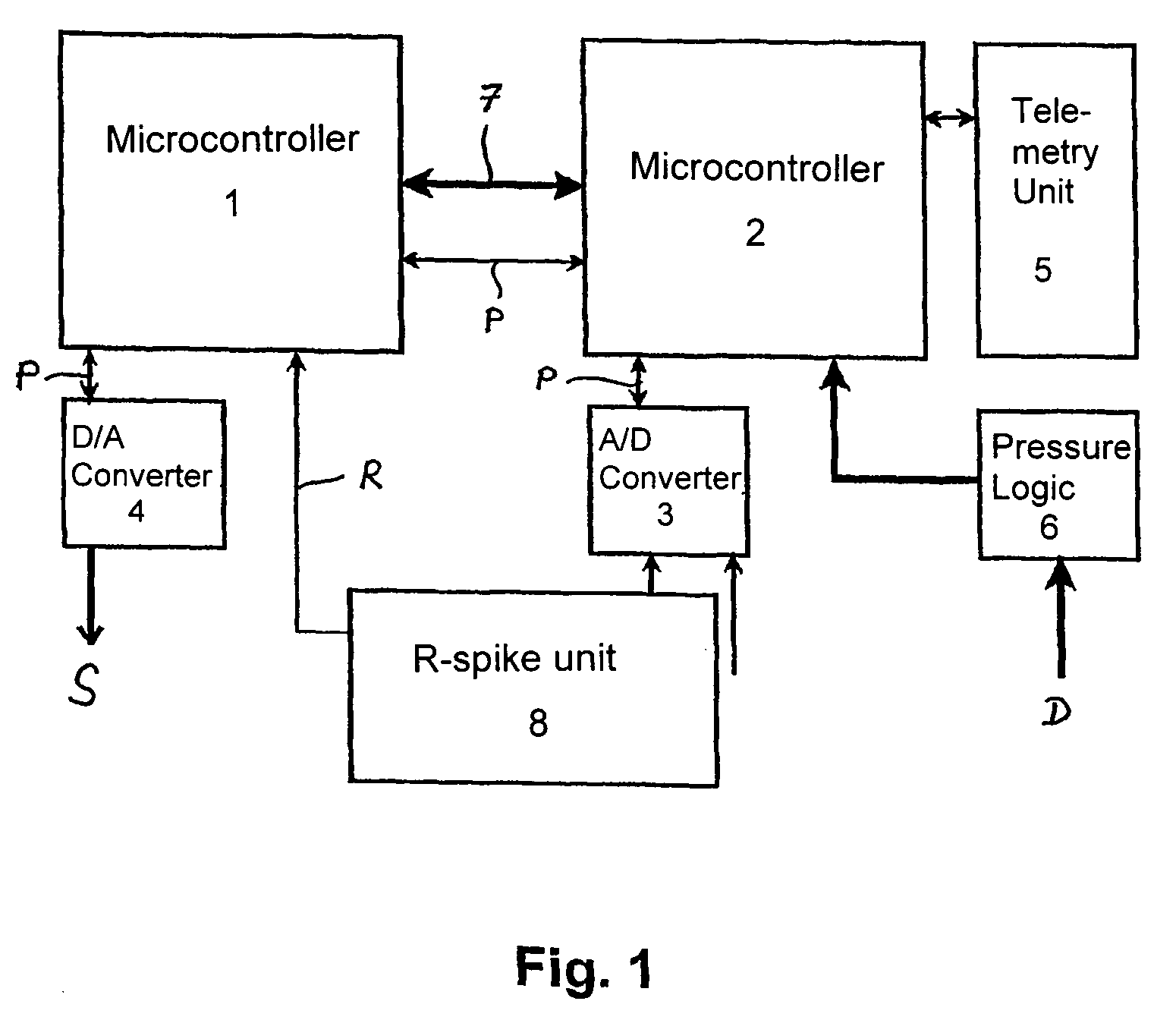[0007]It is therefore an object of the invention to provide a muscle stimulator which makes it possible to preserve type-IIa muscle fibers and, more particularly, to provide an effective heart muscle assist system which operates when needed. The muscle stimulator should also be capable of inducing, through suitable electrical stimulation, the formation of new blood vessels and capillaries for optimally supplying the muscle tissue with blood (neo-vascularization).
[0013]To prevent the stimulated muscles from being overstimulated and the stimulated muscle fibers from being transformed into a weak, slow and hence ineffective type-I muscle tissue, the stimulation pulses transmitted within a definable time interval must be counted and evaluated. This task is performed by the counting unit in cooperation with the storage unit and a monitoring unit. The mean stimulation frequency is a measure for the frequency with which the muscles are stimulated during a certain time interval. To prevent muscle damage, the mean stimulation frequency must not continuously exceed an individually determined limit value.
[0014]Each transmitted stimulation pulse is counted and computed over an extended observation time to yield a mean stimulation frequency. A longer observation time according to the invention has a duration of at least 30 minutes, in particular one hour or several hours. Advantageously, observation times are 12 or 24 hours. The mean stimulation frequency must be determined individually for each patient and must not exceed a maximum value of the 0.2 to 2 pulses per second (Hz), in particular 0.7 to 1 Hz, so as to prevent overexertion of the muscle and a medium-term muscle destruction. The mean stimulation frequency should therefore be evaluated so as to arrive at the desired muscle transformation and preservation effect, and to control the transmission of stimulation pulses depending on the outcome of the evaluation. For this purpose, a continuously operating evaluation unit for observing the limit values for the mean stimulation frequency is provided, wherein the limit values can be individually set in a range of 0.2 stimulation pulses per second to 2 stimulation pulses per second. Pulse conservation means, also referred to as pulse saving means, are provided for adapting and, more particularly, reducing the mean stimulation frequency as a function of the measured mean stimulation frequency and the defined desired values of the evaluation unit. The pulse conservation means include a computing unit for computing a modified stimulation pattern according to an equation which depends on the mean stimulation frequency. In addition, a memory module for storing the temporal course of the number of supplied stimulation pulses can be provided, as well as means for program-controlled transmission of the mean stimulation frequency from the determination unit to the computing unit. Moreover, an analysis unit can be provided for determining when and how often certain limit values of the heart rate and / or of the mean stimulation frequency are exceeded or underrun.
[0015]The counting unit and the memory unit can be housed in the aforedescribed housing. The determination unit and / or the pulse conservation means can also be integrated in the housing. Optionally, the memory module and / or the analysis unit can also be integrated in the housing that houses the control unit. The housing can be implanted in the body of the wearer of the device of the invention. An energy storage device which can preferably be recharged transcutaneously can also be associated with the housing. This increases the operating time of the implanted part of the device.
[0017]It is another object of the invention to provide a combination of specially developed electronic devices for muscular heart assist systems, in particular for muscular blood pumps, capable of generating and maintaining type-IIa muscle fibers. The invention also relates to a myo-stimulator which can be programmed to preoperatively generate through percutaneous stimulation type-IIa muscle fibers showing less fatigue. This device can include an implantable myo-stimulator and a monitoring unit which effectively contracts the muscle with type-IIa muscle fibers, prevents conversion to type-I muscle fibers, and also prevents destruction of muscle from excessive stress. The monitoring unit associated with this implantable myo-stimulator can be used as a programming unit as well as a measurement and display device. The monitoring unit can transmit information either wireless or by a wired connection from the bio-stimulator to the patient or to the attending physician. Additional functions can be incorporated in this device, such as transmitting the ECG of the patient and / or a patient location system for emergencies. This device can also implement to a limited extent the aforedescribed functions in myo-stimulators of other manufacturers.
 Login to View More
Login to View More  Login to View More
Login to View More 


